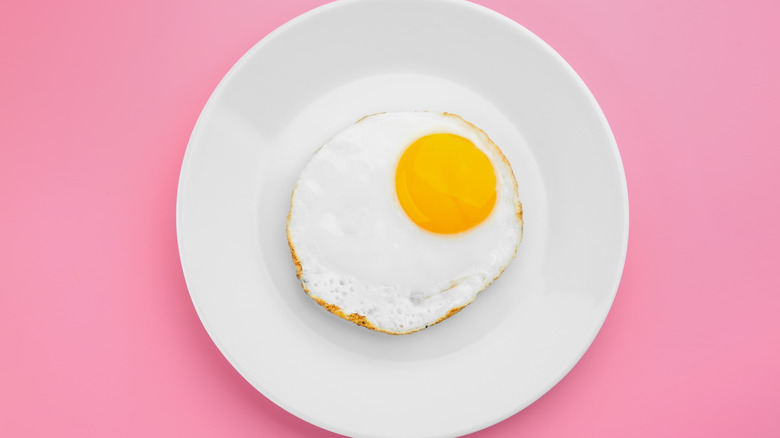Alton Brown's Tip For Evenly Cooked Over-Easy Eggs Every Time
Eggs seem so simple, but they leave the door open for improvement. For example, you can forgo a messy flip of over-easy eggs by adding water to your pan, or improve over-medium eggs by keeping your eye on the edges of the whites. Celebrity chef Alton Brown, however, has one simple trick up his sleeve. To make more consistent, evenly cooked over-easy eggs, Brown recommends grabbing a small bowl before you ever turn on the heat.
Specifically, Brown — who believes breakfast is the most important meal of the day — takes his time to make eggs. Rather than crack them directly in a pan, he instead uses a custard bowl or ramekin first. According to Brown, "It's the only way to make sure they cook evenly, and you can pour them into the pan right where you want them," per Food Network. Essentially, the bowl technique allows Brown to pour, then place, his eggs directly and methodically in the pan. Plus, the smaller bowl minimizes the chance that any eggshells will wind up inside the pan.
Yet while this step is important to avoid unevenly cooked eggs, Brown's eggs aren't ready quite yet. Rather, he starts with a custard cup before adopting a low and slow cooking approach.
Alton Brown is methodical about cooking eggs
Eggs may be straightforward to cook, but the best over-easy eggs are a practice of patience. After cracking his eggs into a custard bowl, Brown is ready for some heat. Rather than rush this process, however, he pre-heats his pan — specifically, an eight-inch nonstick — over low heat. As the pan warms, he melts a tablespoon of butter. Once his butter has fully melted, only then does Brown pour his already-cracked eggs into the pan. He maneuvers the eggs so they congregate on the far side of the pan, rather than spread across the entire surface area. He then seasons them with salt and pepper, and flips the eggs, frying them on both sides, always keeping the temperature on low. This consistency of heat is pivotal, as a low temperature likewise improves the chances of evenly-cooked eggs. A too-high temperature tends to result in eggs that cook too quickly on the bottom and burn, while the top part remains underdone.
Once the eggs are fully cooked on both sides, they're ready to eat. Easy may be in the name of over-easy eggs, but there's no such thing as over-even eggs, so it's best to follow Brown's advice — and grab an extra custard bowl.

